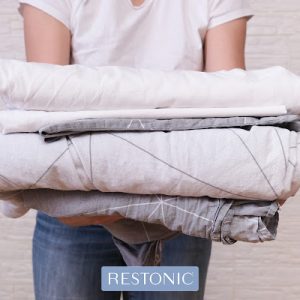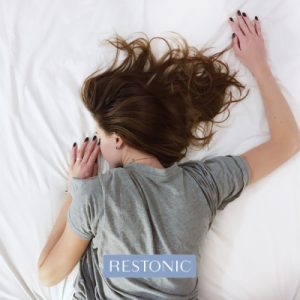 Dream on: what you need to know to make your bed the perfect sleep space
Dream on: what you need to know to make your bed the perfect sleep space
In the market for new bedding but don’t know where to start? That’s no surprise. These days there are so many options for bed sheets – from fabric types to thread counts, colors and design. All the choices can make your head spin. Choosing your next dreamy sheet set is a big decision, and often a big investment too. Before laying down your cash, a little research is in order. But where to start?
Right here, of course.
We’ve gathered up all the information you need to make the perfect sheet selection that suits your sleep style.
What is thread count and why does it matter?
Thread count is the number of fibers woven into a square inch of fabric and is used to measure durability and softness. Generally, higher thread count means softer (more velvety) , more durable – read: more expensive. Good sheets run from 200 to 800 thread count, with the 5 star hotel quality sheets running up to 1,000 thread count.
But don’t let a super high thread count on the label fool you; the number can be inflated by weaving fibers from different types of cotton together. Some 200 thread count sheets are finished beautifully and have a much more luxurious feel than you might expect. Plus, when looking at patterned or printed fabrics for duvet covers, for example, a lower thread count is a better option as it will result in better breathability and a less stiff product.
Tip: When shopping for bed sheets, thread count is mostly applicable to only cotton, and is just one feature to consider. Type of cotton and weave style are equally important. While that seems confusing, what it really means is that choosing sheets is highly personal. Decide what’s most important to you (price, feel, washability, durability), and let that guide your decision-making process.
 Do differences in bedding fabrics really affect sleep quality?
Do differences in bedding fabrics really affect sleep quality?
There’s no clear answer to this question, except to say that the desirability or suitability of a fabric is in the eye of the beholder. In the past, we believed that cotton sheets were overall ‘better’ (but we really weren’t sure why, other than our mom told us so). Cotton certainly is the original performance fabric. Breathable, moisture-wicking, soft yet durable, naturally hypoallergenic and super comf.
But, with advancements in technology, there are so many more choices available these days. While all cottons are breathable and absorbent, some will be softer and more durable than others – with a price that reflects the difference. And for those who are cost or eco-conscious, or who are looking for extreme softness, improvements in manufacturing and finishing processes mean that a blend of synthetic fibers might suit them better than 100% cotton.
When it comes to bed sheets, it’s all in the fabric
Cotton sheets. Cotton sheets are made from the fibers of the cotton plant and are the most common type of sheeting because the materials are readily accessible. However, not all types of cotton are the same, offering different levels of feel, durability, usage and price point.
Most cotton sheets remain soft even after many washes, and are durable, holding their color and shape for 3-5 years or more. Due to the type of weave, cotton fabrics are breathable and absorbent, making them ideal for hot sleepers.
- Egyptian cotton sheets. The highest quality cotton (and therefore the most expensive). The long fibers are woven to produce thin and light, yet long-lasting, soft, and sumptuous bed sheets.
- Pima & Supima cotton sheets. The next best thing to Egyptian, these varieties are made from American cotton, and are somewhat less common. Pima is grown in just 3 countries around the world, and Supima, just in the US. Their price points fall just below Egyptian and they are considered a luxury cotton.
- American upland cotton sheets. If the label non-specifically reads ‘cotton’, then it’s probably upland cotton. This type of cotton produces fibers that are shorter and less durable than the more expensive Egyptian or Pima cotton. Sheets made from this type of cotton may be less soft, might pill more easily, and won’t last as long or feel as luxe to the skin. But, they will give you the experience and benefits of cotton sheets at a much lower price point, making them a great choice for many.
- Cotton flannel sheets. Also known as brushed cotton, flannel is a thick yet lightweight bedding material. It’s produced from loosely spun cotton that’s brushed, creating a soft pile on the surface. Flannel may also have wool or polyester woven into it for increased durability. Flannel sheets are warm and cozy due to the soft pile that is created during the brushing process. They’re best for cooler climates or for people who sleep cold.
 Cotton jersey sheets. Made of cotton that’s knit rather than woven, these sheets are super comfy and soft (imagine sleeping in your favorite t-shirt!). They’re reasonably priced and breathable, but lack the cool, sleek crispness of cotton woven sheets. Economical for students or if you need a quick replacement for a spare bedroom they aren’t as durable as other types of sheets and may fade or lose their shape after repeated washing.
Cotton jersey sheets. Made of cotton that’s knit rather than woven, these sheets are super comfy and soft (imagine sleeping in your favorite t-shirt!). They’re reasonably priced and breathable, but lack the cool, sleek crispness of cotton woven sheets. Economical for students or if you need a quick replacement for a spare bedroom they aren’t as durable as other types of sheets and may fade or lose their shape after repeated washing.- Polycotton sheets. Woven with a blend of manufactured polyester fibers and natural cotton, this material is less expensive than 100% cotton. While not as soft and luxurious as cotton sheets, it’s very easy to care for, dries fast and wrinkles less, making it the perfect choice for guest bedrooms – watch for 50% cotton or higher for increased comfort.
- Polyester microfiber sheets. Woven from fine polyester threads to create a tight weave and then lightly brushed to create a soft touch, microfiber sheets are a great option for those looking for well-priced, easy-care bedding. The fabric results in versatile, washable no-wrinkle bedding that holds its color and lasts. It’s less breathable than cotton, so not an ideal choice for those with sensitive skin, who like cool, crisp bedding, or who sleep hot.
- Natural fiber (linen) sheets. A woven fabric made from fibers extracted from the flax plant. The resulting product is thicker and more durable than cotton and becomes softer the more it’s washed. Linen sheets are eco-friendly, last for years and years, and are great for people with allergies or skin sensitivities. The downside? They wrinkle very easily – perfect if you’re into a more casual boho décor– and are much more expensive than other types of sheets.
Weave matters when it comes to cotton bedding fabrics
Sheets are not just about what they’re made of, but also how the fibers are woven. More relevant for cotton and cotton blend sheets, the weave is an important factor in choosing which type of bedding you’re taking home.
 Percale cotton sheets. This is the most common bed sheet weave, with a criss-cross pattern that results in that smooth, crisp finish we associate with high end sheets. Percale sheets have a thread count of 180 or higher and are durable, lightweight and breathable. Plus, due to their tight weave, they are able to keep their cool, even in hot temps – which of course means they aren’t the best choice for keeping cozy and warm. Due to it’s tight weave and crispness, percale is also prone to wrinkling, which might drive the non-ironers crazy.
Percale cotton sheets. This is the most common bed sheet weave, with a criss-cross pattern that results in that smooth, crisp finish we associate with high end sheets. Percale sheets have a thread count of 180 or higher and are durable, lightweight and breathable. Plus, due to their tight weave, they are able to keep their cool, even in hot temps – which of course means they aren’t the best choice for keeping cozy and warm. Due to it’s tight weave and crispness, percale is also prone to wrinkling, which might drive the non-ironers crazy.- Combed cotton sheets. During the processing of the cotton fibers, fine brushes are used to remove impurities, straighten longer fibers and discard shorter fibers. Combed cotton is then spun into a super soft and durable weave, albeit a little less crisp-looking than percale that has not been combed. Combed cotton is likely to be more expensive than regular cotton, due to the more extensive processing. However, if a little luxe is in your budget, a set of combed cotton sheets with a 200+ thread count might be a great choice.
- Sateen cotton sheets. From its name you might deduce that this process produces fabric with a silky finish. Sateen is woven from cotton with more horizontal threads and a looser weave, resulting in a product that is smooth and luxurious to the touch, making it wrinkle resistant and offering a higher end feel at a lower price. It’s also great for cooler climates as its heavy weight holds the warmth. However, it does snag easily, making it less durable than other options, and will not be a favorite for those who overheat in their sleep.
The decision of how to dress your bed can be more than a little confusing. When it comes down to it, choosing your type of sheets is highly personal, based on need, wish and budget. But, armed with just a little bit of information and all of our tips, you’re bound to be on the right track to choosing the perfect sheets for you.
Rest well & wake up ready to go!
Better sleep gives rise to better mornings, bringing your goals into focus and dreams within reach. Hungry for more sleep info? Dig into these posts:
- What’s your sleep temperature sweet spot?
- Clutter and sleep make terrible bed partners
- The essential guide to creating a bed you’ll love sleeping in
Eager for more sleep info you can really use?
Join our community
Facebook
and let's continue the conversation.
We'd love to hear what you have to say!
This blog does not provide medical advice. It is intended for general informational purposes only and does not address individual circumstances. It is not a substitute for professional medical advice, diagnosis or treatment and should not be relied on to make decisions about your health. Never ignore professional medical advice in seeking treatment because of something you have read on Restonic.com. If you think you may have a medical emergency, immediately call your doctor or dial 911.

